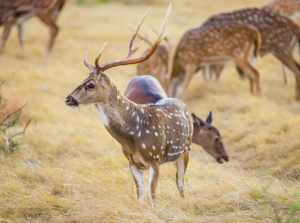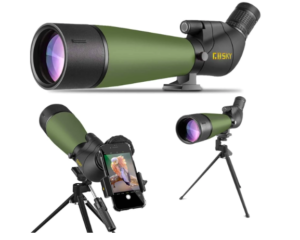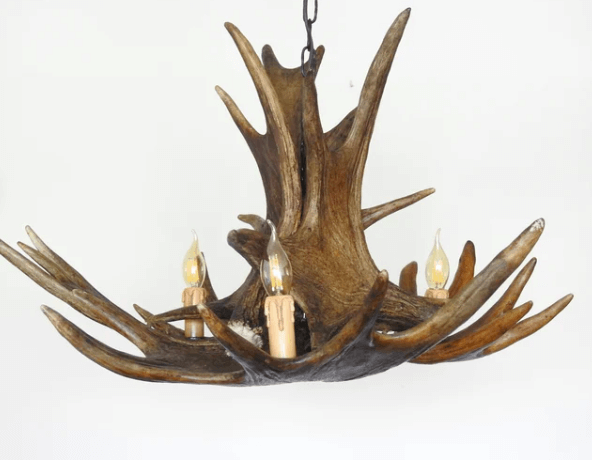
Antler Chandeliers
Few components in home design capture the aura of rustic beauty quite like antler chandeliers. These one-of-a-kind fixtures have the ability to convert any place into a compelling refuge due to their ageless appeal and natural attractiveness.
This trip into the world of antler chandeliers aims to excite, enlighten, and fire your enthusiasm for bringing the beauty of the outdoors into your interior spaces, whether you’re a skilled artisan or an enthusiast with a predisposition for creativity.
What is an Antler Chandelier?
An antler chandelier is a form of lighting fixture made from real or synthetic antlers to produce a one-of-a-kind and eye-catching look. The chandelier usually has a central body or frame fashioned of antlers, which are the branching, bony growths on the heads of deer, elk, moose, and other similar animals.
The antlers used in these chandeliers can either be natural or synthetic:
Natural Antler Chandelier:
These chandeliers are handcrafted from naturally shed antlers. Certain species of deer and other ungulates lose and regenerate their antlers naturally. The antlers of the animals are gathered, cleaned, and recycled for use in chandelier designs once they have lost their antlers. Natural antler chandeliers have an original and rustic beauty since each item is one-of-a-kind owing to the various forms and sizes of the antlers.
Faux Antler Chandelier:
Faux antler chandeliers, on the other hand, are made of synthetic materials such as resin or metal and are intended to seem like actual antlers. These chandeliers are an ethical option for individuals who do not want to use actual antlers but still want to enjoy the rustic and natural style.
Antler chandeliers are available in a variety of forms and sizes, with antlers providing the arms or branches from which light fittings are suspended. They typically use candle-style lights or electric bulbs placed into artificial candle sleeves to create a classic and rustic feel.
These chandeliers are frequently seen in cabins, lodges, rustic-themed residences, mountain getaways, and other locations that strive to blend elements of nature and the great outdoors into their interior design. Antler chandeliers are a discussion grabber in any environment due to their unusual and intriguing appearance.
It is critical to remember that if you intend to use a natural antler chandelier, you must confirm that the antlers were responsibly collected from naturally shed antlers without causing harm to the animals involved. To encourage ethical and responsible home design choices, always verify the sourcing and provenance of the materials.
What is an Antler?
An antler is a branching, bony protrusion that protrudes from the head of animals in the Cervidae family. Antlers are mostly seen on male members of this family and are used for a variety of activities such as warfare, dominance displays, and courting mates.
Antlers have the following characteristics:
Pattern of Development:
Antlers are remarkable in that they shed and regenerate each year. They begin as little bone lumps on the animal’s head known as pedicles. These pedicles evolve into full-grown antlers over time.
Structure of Branching:
Antlers are usually branching, with several tips, or tines, spreading from a central beam. The number of tines and general form of antlers can differ significantly across species and individuals.
Composition:
Antlers are made of bone tissue and are coated in a layer of skin called velvet during growing. When the velvet has fully formed, it dries and sheds, revealing the hard, polished bone beneath.
Function:
Antlers serve a variety of roles depending on the species and the season. During the mating season, they are frequently utilised for battle between males who are competing for access to mates. Antlers are also used in dominance displays and to lure possible mates.
Variation in Species:
The size, form, and structure of antlers vary amongst deer species. White-tailed deer antlers, for example, are thin with a forward curve, but moose antlers are massive and broad, with a palmate (flattened) shape.
It is vital to distinguish antlers from horns, which are seen in other animal groups like as cattle and bison. Horns, as opposed to antlers, are permanent structures comprised of keratin, a protein found in hair and nails.
How To make a real antler chandelier Guide
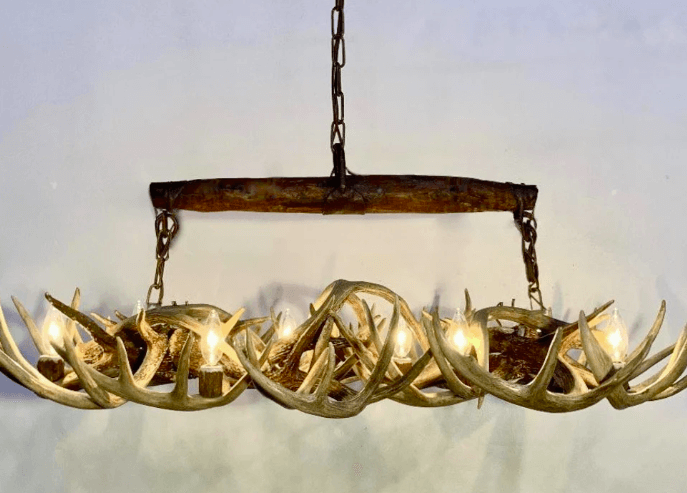
Antler chandeliers are more than simply lighting fixtures, they are works of art that merge the rugged appeal of the wilderness with the refinement of home design. Making your own antler chandelier allows you to create a one-of-a-kind masterpiece that combines natural beauty with utilitarian brilliance.
While the technique can be time-consuming and difficult, the end product is a compelling statement piece that adds character and warmth to any area. We’ll walk you through the process of making your own antler chandelier step by step in this detailed tutorial.
We’ll give you with the information and insights you need to begin on this gratifying creative endeavour, from acquiring the antlers to assembling the electrical components.
Materials You’ll Need: Before you begin, gather the necessary materials to ensure a smooth crafting process:
- Naturally shed deer or elk antlers
- Chandelier frame (pre-made or custom)
- Chandelier wiring kit, sockets, and bulbs
- Chainsaw, handsaw, drill, screws
- Pliers, wire cutters, wire stripper
- Measuring tape, sandpaper, epoxy glue
- Safety gear: eye protection, gloves, dust mask, ear protection
Step-by-Step Instructions:
1. Antler Gathering and Preparation:
For a visually pleasing design, collect antlers of all sizes and forms.
Use a gentle soap and water solution to clean the antlers, being careful not to harm the natural texture.
Trim the antlers using a chainsaw or handsaw to make them fit the chandelier frame.
2. Creating a Chandelier Frame:
Create or buy a chandelier frame that compliments the antlers and adds stability.
Hooks or loops should be attached to the frame where the antlers will be mounted.
3. Antler Arrangement:
Experiment with different configurations by laying the antlers out on a flat surface.
Adjust the layout until you get a visually appealing and balanced design.
4. Wiring and Electrical Work:
Assemble the chandelier wiring kit components as directed by the manufacturer.
Use epoxy glue to attach the sockets to the antlers, or drill holes and thread wires through.
Connect the sockets to the chandelier wiring kit while ensuring sufficient insulation and tight connections.
As directed, attach the chandelier wire kit to the frame.
5. Safety Check and Final Assembly:
Attach the antlers to the chandelier frame with care, using chains, wire, or other fasteners.
Inspect all electrical connections thoroughly to verify they are secure and appropriately insulated.
To ensure the chandelier’s operation, test its electrical components.
6. Installation:
- Hang the chandelier from the ceiling firmly, following local restrictions and safety recommendations. Making a real antler chandelier requires time, imagination, and a dedication to safety.
- You’ll construct a gorgeous centrepiece that not only brightens your room but also demonstrates your artistic skill if you follow this complete instruction and prioritise precise craftsmanship.
What are the types of natural antler chandeliers?
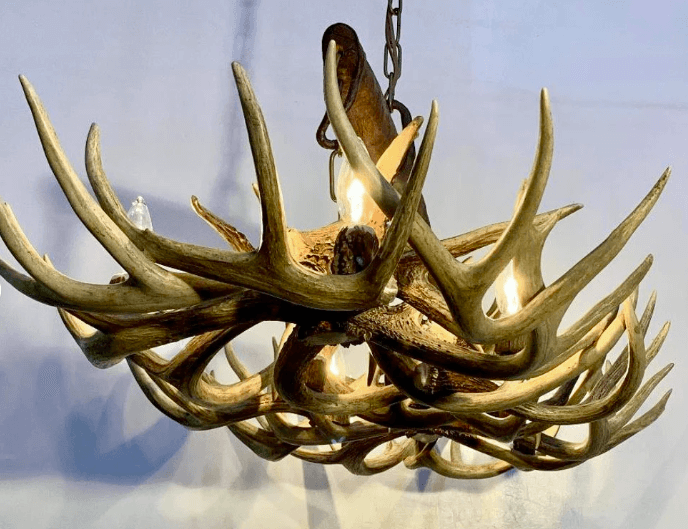
Natural antler chandeliers come in a variety of styles and shapes, each with its own distinct and appealing appearance. Natural antler chandeliers are classified mostly by their arrangement and form. Here are several examples:
Tiered Antler Chandeliers:
Tiered chandeliers have antlers set in numerous levels or tiers, creating a cascading effect. The antlers frequently shrink in size as they progress upward, resulting in an aesthetically pleasing and balanced appearance.
Branched Antler Chandeliers:
Chandeliers with branches mirror the natural branching pattern of antlers. The antlers are utilised to create several arms, or branches, that protrude from the chandelier’s central body. Each branch can have its own light fixture, which adds to the overall lighting.
Wheel or Wagon Wheel Antler Chandeliers:
These chandeliers have a circular frame that looks like a waggon wheel, with antlers spreading outward from the centre. The antlers can vary in size and shape, resulting in a one-of-a-kind and rustic focal point.
Spiral or Twisted Antler Chandeliers:
Spiral chandeliers are made up of antlers that have been twisted or bent around a central axis to create a visually dynamic and intriguing look. The spiralling effect elevates the rustic aspect of antlers by adding a hint of elegance and modernism.
Candle-Style Antler Chandeliers:
Candle-style chandeliers resemble typical candle chandeliers in look, with antlers creating the arms that support candle-like light fixtures. These chandeliers frequently have an antique or historical feel about them.
Cluster or Clustered Antler Chandeliers:
Clustered chandeliers are made up of numerous antlers that are grouped together to provide a compact and visually dense shape. This sort of chandelier can have a more modern and abstract appearance while retaining the natural appeal of antlers.
Linear or straight-line antler chandeliers:
Linear chandeliers have antlers that are set in a straight line or in a linear form, giving them a more streamlined and minimalist appearance than other styles.
Inverted or upside-down antler chandeliers:
The antlers on inverted chandeliers point downward, giving them a distinct and unusual appearance. This style of chandelier may provide a surprise aspect as well as creative flair to the area.
Custom-Made Antler Chandeliers:
Aside from the typical varieties, artists and manufacturers may produce custom-made antler chandeliers to meet unique tastes and interior design needs. Customers may choose the antler type, size, arrangement, and other factors to make each item unique.
Natural antler chandeliers each have their own individual charm and may fit a wide range of home design concepts, from rustic and lodge-style to modern and eclectic. When choosing a natural antler chandelier, consider the size, shape, and arrangement that best meets your aesthetic choices, as well as the size and style of the planned room.
What are the best animal antlers for Real antler chandeliers?
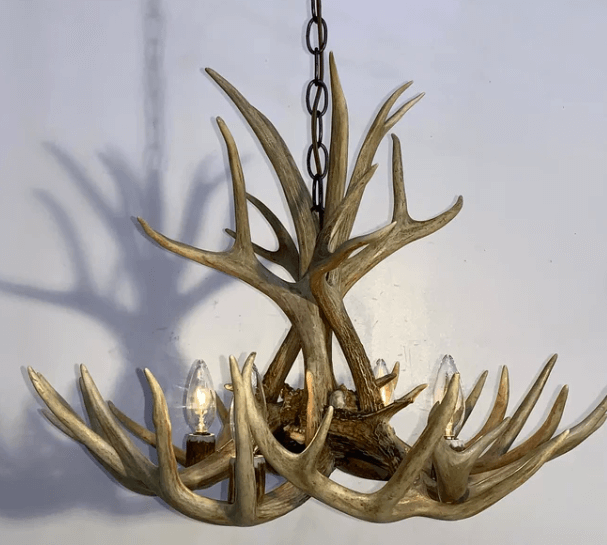
The selection of animal antlers for a real antler chandelier is influenced by various criteria, including beauty, size, availability, and legality. Because of their size and natural shedding patterns, deer and elk antlers are the most usual and popular choices, although other forms of antlers can also be utilised. Consider the following options:
Whitetail or Mule Deer Antlers:
Because of their generally consistent size, complex branching, and availability, deer antlers are commonly utilised for chandeliers. Because whitetail and mule deer lose their antlers every year, they are a sustainable alternative.
Elk Antlers:
Elk antlers are bigger and more durable than deer antlers, making them ideal for larger and more intimidating chandeliers. Elk antlers have a distinct and eye-catching aesthetic appeal.
Moose Antlers:
Moose antlers are considerably bigger than elk antlers and may be fashioned into a magnificent chandelier. However, because of their size, they might be more difficult to discover and deal with.
Fallow Deer Antlers:
Fallow deer antlers frequently feature pronounced palmation, which means the antler tips are flattened and resemble the palm of a hand. This one-of-a-kind element may give your chandelier a distinct look.
Keep the following factors in mind while selecting antlers for your chandelier:
Size and Proportion:
The antlers should be the same size as the chandelier frame and the location where it will be mounted.
Aesthetics:
To create the desired visual effect, consider the antlers’ natural form, colour, and texture.
Quantity:
Collect enough antlers to make an aesthetically beautiful and balanced design. Using different sizes and shapes may provide intrigue.
Ethical and legal sourcing:
Make certain that the antlers were collected legally and responsibly, particularly if they came from a protected or alien species.
Availability:
Certain varieties of antlers may be more available than others depending on your region and resources.
Remember that working with actual antlers necessitates meticulous cleaning, preparation, and, in certain cases, modification to suit the chandelier frame. Furthermore, each antler type brings its own set of obstacles and potential for artistic expression. If you’re unclear about which antlers to use or how to work with them, try speaking with antler chandelier artists or specialists.
How To Maintain A Real Antler Chandelier Full Guide.
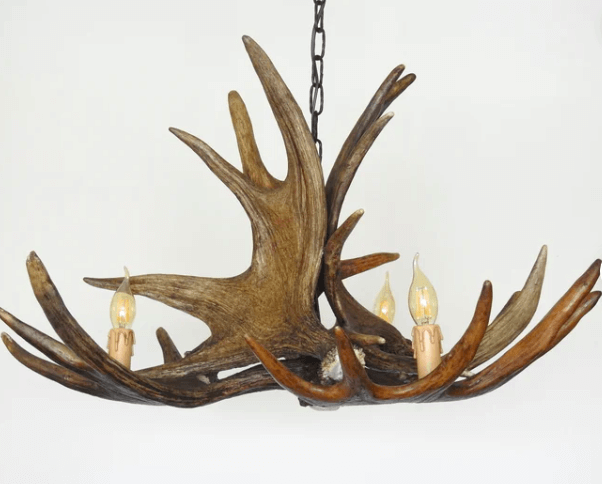
It is critical to maintain a real antler chandelier in order to keep its beauty, assure its durability, and avoid any harm. Here’s a comprehensive guide on caring for and maintaining a real antler chandelier:
Dusting on a regular basis:
To minimise dirt collection, dust the antler chandelier on a regular basis. Dust the antlers and light fixtures lightly with a gentle, dry cloth or a feather duster. Avoid applying abrasive or strong chemicals that might scrape or harm the antlers.
Cleaning:
If the chandelier has to be cleaned more thoroughly, use a mild soap solution and warm water. Dampen a damp towel with soapy water and clean the antlers and light fittings carefully. Remove any soap residue immediately with a clean, moist towel. Wipe with a gentle, lint-free cloth to dry.
Avoid Water Exposure:
Natural antlers are moisture sensitive and can distort or shatter when exposed to water. Never use too much water to clean the chandelier, and never immerse the antlers in water. Consider using a dehumidifier to protect the antlers if the chandelier is in a humid location.
Prevent Sunlight Exposure:
Long-term exposure to direct sunlight can cause antlers to fade or discolour. Place the chandelier away from direct sunlight, or cover it with drapes or shutters during peak hours.
Check for Loose Parts:
Inspect the chandelier on a regular basis for any loose antlers or light fittings. If you come across any, gently tighten them to the frame to keep them from falling and causing harm.
Bulb Replacement:
Check the bulbs on a regular basis and replace any that are burnt out or faulty. To avoid overheating and potential damage, always use the proper bulb type and wattage as indicated by the manufacturer.
Secure Mounting:
Make sure the chandelier is firmly attached to the ceiling or a support structure. The weight of the chandelier may lead it to droop or become unstable over time. Consult a professional if necessary to resecure the mounting.
Avoid Hanging Heavy Items:
Hanging additional heavy goods or decorations from the antler chandelier may cause the antlers and the fixture’s integrity to be compromised.
Repairing Antler Damage:
If you observe any damage to the antlers, such as cracks or fractures, get expert assistance to repair or reinforce the afflicted regions.
Seasonal Maintenance:
Consider doing more extensive maintenance during seasonal changes. Inspect the chandelier, for example, before winter to solve any possible faults before the colder, drier months arrive.
Professional Cleaning and Inspection:
Consider contacting a professional to undertake a complete cleaning and examination of the chandelier every few years.
They can address any hidden concerns and offer maintenance recommendations. By following these care instructions, you will be able to enjoy the beauty of your real antler chandelier for many years while retaining its natural charm and elegance.
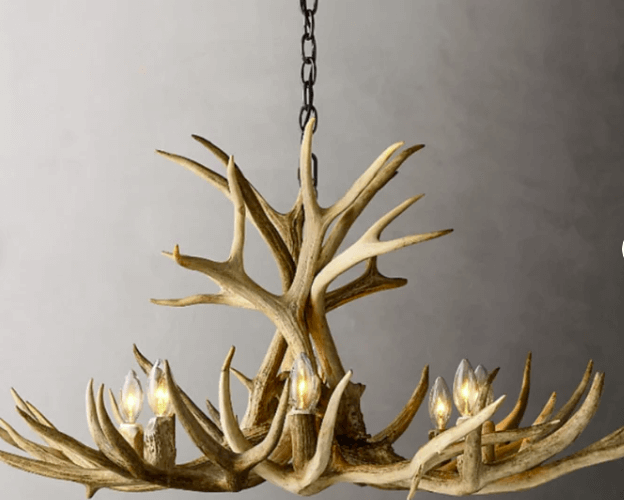
FAQS About real antler Chandeliers.
Are antler chandeliers made from real antlers?
Antler chandeliers are often made from actual animal antlers. These antlers are frequently harvested from animals that naturally shed them, such as deer and elk, guaranteeing a sustainable and ethical source for the materials.
How are antlers sourced for chandeliers?
Antlers for chandeliers are often collected from animals that lose their antlers naturally. These shed antlers are collected by hunters, gatherers, and artists from woods and wilderness places. Some antlers may also originate from antler farms, which rear animals in a controlled setting.
Can I make my own antler chandelier?
Yes, provided you have the appropriate abilities in carpentry, craftsmanship, and basic electrical work, you can make your own antler chandelier. However, due to the intricacy of the procedure and safety concerns, it is suggested that you have prior expertise or seek professional help.
Are antler chandeliers available in a variety of styles?
Yes, antler chandeliers are available in a variety of types and patterns. They can range from rustic and natural-looking chandeliers with basic arrangements to more sophisticated and creative designs with various antler kinds and lighting setups.
How should I clean and care for an antler chandelier?
Use a soft brush or towel to remove dust and dirt from an antler chandelier. Water and cleaning products that might harm the natural finish should be avoided. Regular maintenance entails inspecting the electrical components for problems and ensuring that the antlers are properly fastened to the frame.
Are antler chandeliers appropriate for modern settings?
Yes, antler chandeliers may be used in a variety of decor designs, including modern and contemporary. You may create a stunning contrast by mixing antlers with clean and minimalist designs, adding a touch of nature-inspired beauty to your modern decor.
Can I customize the size and arrangement of antler chandeliers?
Absolutely, antler chandeliers are highly customizable. You may collaborate with artists to create a chandelier that is unique to your home and pick the arrangement, size, and kind of antlers that best suit your aesthetic tastes.
Are there any legal implications to utilising antlers?
Yes, it is critical that the antlers you utilise are lawfully obtained and that they conform with local wildlife and conservation legislation. There are rules in many nations and locations that control the collecting and usage of animal parts, including antlers.
Are antler chandeliers energy-efficient?
The energy efficiency of an antler chandelier is determined by the bulbs used. You may dramatically cut energy usage and boost the chandelier’s efficiency by using LED or energy-efficient lights.
Related
Best Moose Shoulder Mount Taxidermy. Majestic Presence Preserved:
Moose Hunting in Vermont’s Breathtaking Wilderness; Majestic Pursuits
10 Best Deer Shoulder Mounts To Buy: The Art of Deer Mount Taxidermy.
The Ultimate Guide to Elk Hunting in Texas: A Thrilling Pursuit in the Lone Star State.


